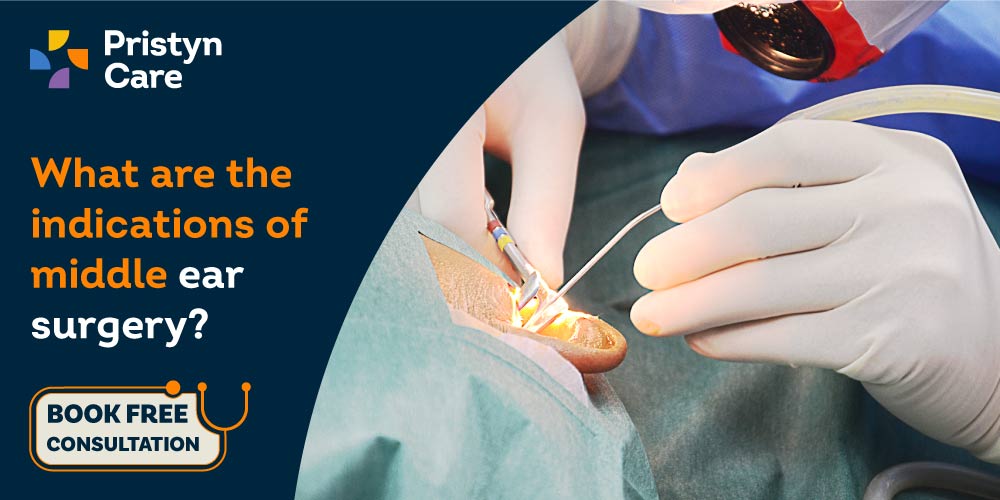Middle ear surgery is commonly performed to correct hearing loss due to middle ear disorders or malfunctions. Middle ear surgery generally involves removal of dead/infected tissue and its replacement with a graft or implant. Surgery is recommended for most patients with severe hearing loss to restore hearing and relieve symptoms.
Some of the common indications for middle ear surgery are listed below.
- Eustachian tube dysfunction
Eustachian tubes help maintain pressure and balance in the ear and protect the ear from excessive noise and runny nose. Dysfunction of the Eustachian tube occurs due to problems with its valve. This means the valve may stay open or not open properly.
Otitis media, commonly known as otitis media, is a viral or bacterial infection of the middle ear. Ear infections can trap ear discharge behind the eardrum.
The eardrum (or tympanic membrane) is an important part of the hearing process. However, they can tear as a result of trauma, loud noises, sudden changes in air pressure, etc. Perforations cannot function properly and usually do not heal on their own. Patients are also more likely to get ear infections.
A cholesteatoma is a noncancerous middle ear cyst that begins at the rim of the eardrum and grows to invade the middle ear and mastoid process. It can also cause degeneration of the middle ear bone. It can be present as a birth defect, but commonly occurs as a result of a recurrent ear infection.
Conductive hearing loss occurs when a person has a disorder that affects the outer or middle ear, making it difficult for sound to pass through them. Patients cannot hear soft sounds, and loud sounds may be muffled.
Otosclerosis occurs when there is abnormal bone growth in the ear. This allows the stapes (stapes) bone to fuse with the surrounding bone, making it less likely to vibrate. It can lead to severe hearing loss and, rarely, hearing loss.
What is the part of the middle ear?
Middle ear surgery involves treating disorders and dysfunctions of the middle ear canal. The middle auditory canal begins with the eardrum, the middle ear bone, and the mastoid cells. The main part of the ear where sound vibrations are collected and amplified for proper hearing. The parts of the middle ear are:
- eardrum: The eardrum is a thin tissue membrane that separates the outer and middle ear. It collects sound vibrations from the outside and conducts them to the ossicles for amplification.
- Small bones (hammer, anvil, stirrup): The ossicles are a setup of three small bones involved in the conduction and amplification of sound vibrations.
- Mastoid cavity of temporal bone: Mastoid cells surround the ear canal and play a role in regulating ear pressure and protecting the ear from trauma.
What types of middle ear surgery are there?
Treatment of middle ear conditions depends on the individual treatment. Some of the common types of middle ear surgeries and treatments are:
- Eustachian tube surgery
There are different types of treatment based on the type of ear tube dysfunction and its cause. Severe eustachian tube dysfunction is treated with implants, fillers, and graft transplantation, while obstructive eustachian tube dysfunction is treated with a variety of surgeries, including tympanostomy tube insertion and balloon dilatation.
- Myringotomy (with Eustachian tube insertion)
Myringotomy surgery is the drainage of middle ear fluids such as blood and secretions. It is usually done for patients with severe ear infections. During the procedure, a small incision/hole is made in the eardrum to drain any blood, fluids, or pus trapped in the eardrum. Sometimes a small tube called a myringotomy tube is briefly inserted into the eardrum to help keep it drained for a long time.
myringoplasty Treatment of eardrum perforation by repairing the damaged portion of the ear canal with a graft or prosthesis. Tympanoplasty involves removing the damaged portion of the ear canal, such as the eardrum and ossicles, and replacing it with a graft or prosthesis.
Myringoplasty is the most common type of tympanoplasty. Myringoplasty is done to repair a hole in the eardrum by replacing it with a graft membrane taken from another place in the body.
Osbroplasty is the reconstruction of an interrupted or destroyed middle ear ossicular chain, using a prosthesis to restore sound/vibration transmission through the middle ear.
a mastectomy This is an operation to remove the affected part of the mastoid bone. In mild cases, removing the diseased cells from the air-filled spaces of the bone is enough, but in severe cases, most of the bone must be removed. It is commonly used for cholesteatoma and severe ear infections that spread to the skull. It can also be performed on patients who need cochlear implants.
stirrup resection A procedure used primarily to treat hearing loss due to otosclerosis, a damage to the small U-shaped middle ear bone called the stapes, that replaces the damaged bone with a prosthesis.
Middle ear surgery is very common and restores hearing in most patients without complications. If you have hearing problems, Consult an otolaryngologist Delaying treatment of middle ear problems can increase the likelihood of complications after surgery, so proper treatment should be sought immediately for proper treatment.
https://www.pristyncare.com/blog/what-are-the-indications-of-middle-ear-surgery/ What are the indications for middle ear surgery?

